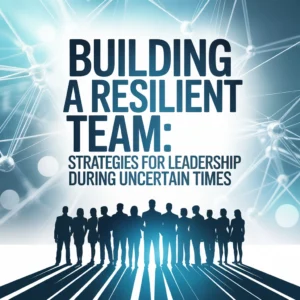As an MD or senior leader, people management can feel like a constantly shifting landscape. There’s never a single right answer, just a set of effective techniques to keep your team focused, engaged, and performing at their best, even when change is the only constant. Below, we’ve mapped out practical, real-world techniques you can put into action to get the best out of your team and yourself.
1. Lead With Communication and Empathy
Strong leadership starts with clear, honest conversation. Don’t just push information outwards—bring active listening front and centre. Make time for regular one-to-ones, keep your language direct and open, and pay attention to non-verbal cues. Empathy in leadership isn’t about being soft; it’s about understanding what motivates each team member and responding to their needs.
Try this:
Kick off team meetings with a quick check-in round. Ask, “How’s everyone doing today?” It’s simple, but it opens the door for honest dialogue. If you sense a dip in morale or energy, address it head-on.

Framework: The P.E.O.P.L.E. Model
- Purpose: Remind your team why their work matters.
- Empathy: Show you care about people, not just their performance.
- Ownership: Give responsibility and trust people to take action.
- Personalise: Avoid a one-size-fits-all approach.
- Listen: Don’t just direct—listen and learn.
- Evolve: Stay curious and encourage innovation.
2. Invest in Coaching, Not Just Giving Orders
It’s tempting as an MD to come loaded with answers, but sustainable performance happens when you coach your people to find their own. Coaching means asking more than telling and making it safe to try, fail, learn, and try again.
Actionable tip:
Ask developmental questions in your regular catch-ups—“What would you do differently next time?” or “Where do you feel most challenged at the moment?”
Consider setting up a mentoring programme or peer learning sessions. Allow team members to share skills and advice across different levels of experience.
Further reading:
- How great leaders coach their teams (YouTube)
3. Make Feedback and Accountability Part of Your Rhythm
Regular, actionable feedback is essential. Don’t let issues fester until annual reviews. Create a feedback loop that’s two-way: praise what’s going well, address what isn’t, and ask for constructive suggestions from your team as well.
What works:
- Give feedback within 3 days of the observed behaviour, good or bad.
- Focus on behaviour and impact, not personalities.
- Celebrate wins—both the big results and “quiet” progress.
Set clear expectations upfront, and follow up. Accountability isn’t about blame—it’s about owning the outcome together.
Stat to know:
Employees who receive regular feedback are twice as likely to feel connected to the company. (Gallup, 2023)
4. Delegate to Develop, Not Just to “Get Stuff Done”
Delegation isn’t about offloading the jobs you don’t want. It’s about matching tasks to the person who will learn and gain the most. This helps people stretch their wings, makes your bench stronger, and frees up your own calendar for strategic work.
Simple method:
- Identify tasks that align with team members’ growth goals.
- Clearly define the result, then give them space to choose the method.
- Offer support, but don’t hover.

To see delegation in action, check out our insight on Transformative Leadership on Tap: The Real-World Impact of Part-Time Directors.
5. Be Proactive With Conflict Resolution
Conflict is part of any dynamic team. What sets high-performing leaders apart is how they handle it. Address issues early and directly, don’t let resentment fester.
Practical technique:
- Have a private, calm conversation.
- Listen to each perspective.
- Seek common ground and agree on next steps.
Model composure and fairness under pressure, and your team will mirror your approach.
6. Decision-Making: Involve, Consider, and Close
As a senior leader, your decisions ripple far and wide. Bring your team into the process; constructive conflict sharpens thinking. Be transparent about how decisions are made and when feedback is needed.
The 3 C’s:
- Constructive conflict: Encourage healthy debate and alternative views.
- Consideration: Make sure all voices are genuinely heard.
- Closure: Define what ‘done’ looks like and confirm when a decision is final.
LinkedIn poll:
Many leaders cite paralysis by analysis as their #1 obstacle to decision-making. Discomfort is normal—clarity comes from bringing others along the journey.
7. Strengthen Self-Awareness and Emotional Intelligence
Self-awareness is the starting point for great people management. Regularly check in with yourself: Am I leading as I want to be led? Where are my stress points? Which situations bring out my best (and worst)?
Invite feedback from peers and trusted mentors. Consider using simple EI tools or leadership journaling to spot patterns and grow.
Watch:
Daniel Goleman on Emotional Intelligence in Leadership
8. Adaptability and Resilience: Stay Agile
Change happens, whether it’s external market shocks or internal restructures. Stay adaptable and keep your team positive through honest updates, visible problem-solving, and flexibility.
How to model resilience:
- Acknowledge obstacles by name, don’t sugar-coat.
- Share plans and real timelines, not just broad visions.
- Celebrate progress, even if it’s not all plain sailing.

Encourage your team to bring new ideas and challenge existing ways of working. Those who feel empowered to innovate are far more likely to be engaged even in choppy waters.
Frequently Asked Questions
What’s the most important skill for people management as a senior leader?
It’s a blend: communication, emotional intelligence, and the ability to develop and empower your people.
Should I manage everyone the same way?
Absolutely not. Personalise your approach. What motivates one person can demotivate another.
How do I know if my feedback is working?
If your team is growing, collaborating smoothly, and meeting objectives, your feedback culture is working. If issues are regularly swept under the rug, it’s time to refresh your approach.
Quick Checklist: People Management for MDs and Senior Leaders
- Have regular, open communications—not just formal updates
- Invest time in coaching, not just directing
- Give frequent, specific feedback (and invite it back)
- Delegate for growth as well as delivery
- Deal with conflict early and directly
- Involve your team in decision-making
- Grow your self-awareness and resilience
- Stay flexible and ready for change
Learn more insights from Leadership Services.
Further Reading and Resources
- LinkedIn Learning: Leading Without Authority
- YouTube: Radical Candor explained
- McKinsey: The five trademarks of agile organisations
For more practical insights and leadership guidance, keep an eye on our Insights hub.


